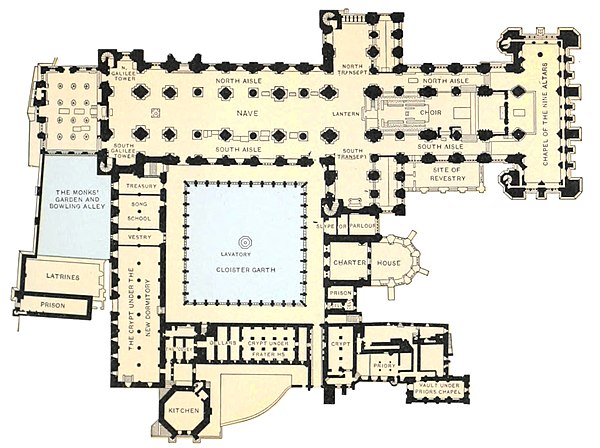gathered round them settlements which, particularly in England and Germany, in the course of time developed into great centres of population and industry. Many important towns owe their origin to this cause; but the tendency never showed itself in Africa and the East. Though the sites selected were often beautiful, many settlements, especially in Egypt, were of set purpose made amid arid deserts. Nor was this form of austerity confined to them. In the Middle Ages, the more dismal and savage did the site appear to be, the more did it appeal to the rigid mood of the Cistercians. Still, the preference, at least with the majority of the monks of the West, was for fertile lands, suitable for cultivation and agriculture.

Ground Plan of Durham Cathedral and Abbey
The formation of communities dates from pre-Christian times, as witness the Essenes; but the earliest Christian monastic foundations of which we have definite knowledge were simply groups of huts without any orderly arrangement, erected about the abode of some solitary famous for holiness and asceticism, around whom had gathered a knot of disciples anxious to learn his doctrine and to imitate his way of life. Communities that had outgrown the accommodation afforded by their monasteries founded branch houses, and thus propagated themselves like the swarming of a beehive. Bishops founded many monasteries, while others owed their existence to the piety of princes and nobles, who also generously endowed them. The Council of Chalcedon (451) forbade the foundation of any monastery without the permission of the local bishop, thus obviating the difficulties likely to arise from irresponsible action. This became the universal law, and it also safeguarded these institutions against disbandment or ruin, since they enjoyed a certain sacredness of character in popular estimation. Double monasteries were those in which dwelt communities both of men and women at one and the same time, under the government of a common superior, either an abbot or an abbess. The Emperor Justinian suppressed them in the East on account of the abuses which this arrangement might lead to; but the custom long prevailed in England, France, and Spain, where strict rules, keeping the sexes entirely separate at all times, minimized the danger of scandals. Examples of these were the houses of the Order of St. Gilbert of Sempringham; and in France, Faremoutiers, Chelles, Remiremont, etc.
In the beginning, solitaries attached no importance whatever to the form of design of their dwellings. They made use of anything that Nature afforded, or their circumstances suggested. In the East, especially in Egypt, abandoned tombs and burial caves; in the West, cave and rude huts constructed of branches of trees, mud, or sun-dried bricks, and furnished with the barest necessities, sheltered many an early solitary. When the number of such solitaries in a certain locality grew, and huts increased in proportion, gradually they came to subject themselves to a common superior and to follow a common rule of life; but they had no common buildings except a church to which they all repaired for the Sunday services. At Tabennæ on the Nile, in Upper Egypt, however, St. Pachomius laid the foundations of the cœnobitical life, arranging everything in an organized manner. He built several monasteries, each containing about 1,600 separate cells laid out in lines as an encampment, where the monks slept and

